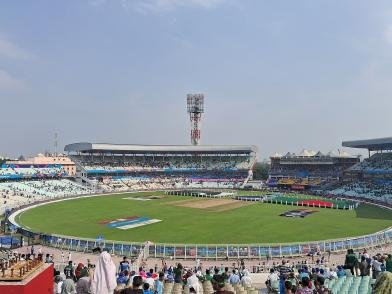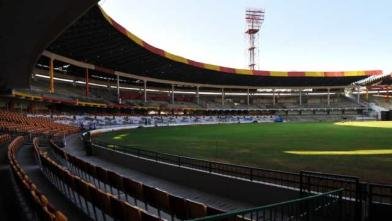❤️ A Cricketing Fortress of Chennai
Nestled in the vibrant heart of Chennai, the M.A. Chidambaram Stadium, fondly known as Chepauk, is a shining beacon of India’s cricketing legacy. Located steps from the scenic Marina Beach, this historic venue is celebrated for its spin-friendly pitch, electrifying IPL showdowns, and monumental Test victories. Home to the Chennai Super Kings and their passionate “Whistle Podu” army, the stadium pulses with energy, fueled by local icon Mahendra Singh Dhoni. From its rich history to its modern upgrades, Chepauk is more than a cricket ground—it’s a celebration of the sport’s soul in Tamil Nadu. Explore its storied past, unique features, unforgettable moments, and detailed pitch report below.
History of the Stadium
The M.A. Chidambaram Stadium, affectionately called Chepauk, is India’s second-oldest cricket stadium still in use, established in 1916. Initially known as the Madras Cricket Club Ground, it was renamed after M.A. Chidambaram, a former BCCI president who played a pivotal role in its development. The Tamil Nadu Cricket Association (TNCA) took over in 1966, and the modern stadium was constructed by 1981 with funding from the Tamil Nadu government, Chidambaram’s contributions, and bank loans. The stadium’s purpose was to cement Chennai as a cricketing hub, fostering both domestic and international matches. It has hosted historic moments, including India’s first Test victory against England in 1952, a landmark for Indian cricket. The 1986 India-Australia Test, ending in only the second-ever tied Test match, remains etched in history. As the home of the Chennai Super Kings (CSK) since 2008, Chepauk continues to be a fortress of cricketing excellence.
Location and Accessibility
Nestled at 1, Wallajah Road, Chepauk, Triplicane, Chennai, Tamil Nadu 600002, the stadium is located near the iconic Marina Beach, adding scenic charm to its appeal. It’s easily accessible from Chennai International Airport, about 20 km away, via a 30–45-minute taxi or cab ride, depending on traffic. Alternatively, visitors can take the Blue Line metro to Government Estate station and cover the remaining 2 km by auto-rickshaw or a short walk. The adjacent Chepauk MRTS Railway Station offers convenient rail access. Nearby landmarks like the Kapaleeshwarar Temple and Fort St. George make it easy to combine a match day with sightseeing. On match days, public transport is recommended due to limited parking and heavy traffic around Wallajah Road, Bells Road, and Victoria Hostel Road.
Architecture and Design
The M.A. Chidambaram Stadium has a seating capacity of approximately 38,000, though historical records cite up to 50,000 before recent renovations. The 2023 upgrades introduced the Anna Pavilion, named after former Tamil Nadu CM M. Karunanidhi, increasing capacity from 31,140 during construction. Designed to leverage its proximity to the Bay of Bengal, the stadium’s open stands allow sea breezes for natural ventilation, a thoughtful feature in Chennai’s humid climate. The pitch is famously spin-friendly, with a dry, dusty surface that slows over time, favoring spinners in longer formats like Test matches. Field dimensions vary, with longer straight boundaries than square ones, tailored to match requirements. Floodlights installed in 1996 and 24 air-conditioned corporate boxes added in 2010 ensure the venue meets international standards.
Famous Matches and Events
Chepauk has been the stage for unforgettable cricketing moments. In 1952, India secured its first Test win here, defeating England by an innings and 8 runs. The 1986 India-Australia Test ended in a historic tie, a rare feat. Virender Sehwag’s 319 against South Africa in 2008 remains India’s highest individual Test score at the venue, while Narendra Hirwani’s 16/136 against West Indies in 1988 is the best by a Test debutant. The stadium has been a stronghold for Chennai Super Kings, hosting IPL finals in 2011, 2012, and 2024. It also welcomed five matches during the 2023 Cricket World Cup. Beyond cricket, Chepauk occasionally hosts cultural events, but its cricketing legacy—marked by records like Saeed Anwar’s 194 in 1997 (then the highest ODI score)—defines its global fame.
Facilities
Spectators at Chepauk enjoy modern amenities, including comfortable seating across stands like the Anna Pavilion and President’s Box, large LED screens for live action, and free drinking water stations to combat Chennai’s heat. Food stalls offer snacks, though some visitors note high prices. Parking is limited, with spaces at Kalaivanar Arangam, Madras University Campus, and nearby areas, making public transport a smarter choice on match days. Players benefit from state-of-the-art dressing rooms and a new indoor training facility added in 2023. The media center supports global broadcasts with dedicated spaces for commentators and press. Accessibility features, such as wheelchair seats in the I lower stand, ensure inclusivity for all fans.
Unique Features
The stadium’s design channels sea breezes from the Bay of Bengal, creating a breezy, comfortable environment for spectators. Its 24 air-conditioned corporate boxes offer a premium experience with dining options, ideal for corporate or VIP guests. The “Whistle Podu” chant of CSK fans transforms Chepauk into a sea of yellow during IPL matches, creating an electrifying atmosphere. Giant LED screens enhance the viewing experience with live updates and replays. The spin-friendly pitch, influenced by Chennai’s humid climate, makes Chepauk a unique challenge for players, often shaping match strategies. The stadium’s plastic-free and tobacco-free policies reflect its commitment to a clean, safe environment for all.
Ticket Booking
Tickets for matches at M.A. Chidambaram Stadium can be purchased online through platforms like District or PayTM, offering seat selection and digital payment, with tickets delivered via email or app. Offline, the stadium’s box office operates from 10:00 AM to 5:00 PM on non-match days and until the match ends on game days. Prices range from ₹1,700 to ₹7,500, depending on the stand, with premium options like the Anna Pavilion being pricier. Advance booking is crucial for high-demand matches, especially CSK IPL games, as popular sections sell out quickly. Secondary marketplaces may offer tickets if official channels are exhausted, but authenticity should be verified to avoid scams.
Fan Experience
Chepauk’s crowd is renowned for its cricketing knowledge and sportsmanship, famously giving standing ovations to opponents like Saeed Anwar for his 194 in 1997. During CSK matches, the atmosphere is electric, with fans chanting “Dhoni! Dhoni!” and creating a vibrant sea of yellow. Visitors praise the breezy environment post-2023 renovations, though some note irritation from smoke guns used during celebrations. A fan shared, “Watching an IPL match at Chepauk is a memory for life—the crowd’s energy makes every ball thrilling.” The blend of historic significance, passionate fans, and modern amenities makes Chepauk a must-visit for cricket enthusiasts worldwide.









